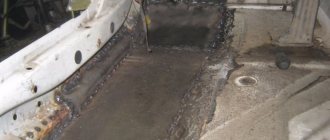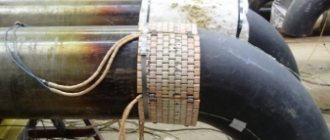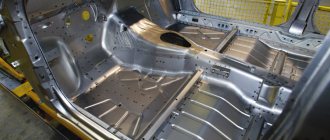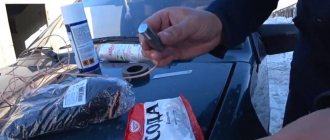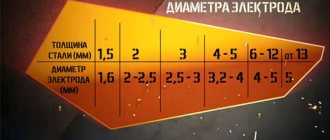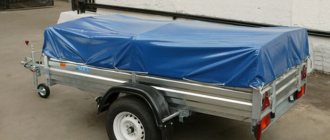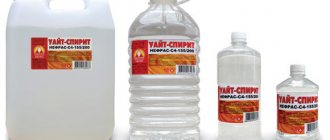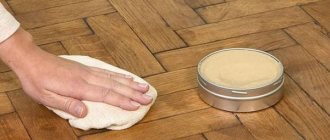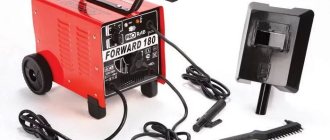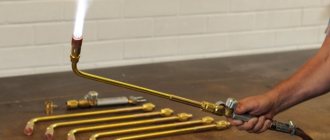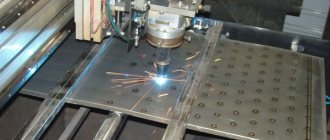So this and the previous post were written late because I was on vacation
3 days after welding, I flew to treat the bottom and hidden cavities!
2 bottles of bitumen rubber treatment and 2 bottles of Movil
I scrubbed the entire floor in the cabin with a brush
And flew off for processing
As always, my work began with dismantling the car) there were cracks in the roof and it was decided to weld them and strengthen them with iron from the inside
I came to work as usual to my friend Alexander santei-2110 I had to kick out his monster
put the door in place and treated it with Movilya
then Alexander began to process my car inside and out
The stench was terrible for about 5 days, I had to leave the windows open
I also had a trip of 800 km ahead of me on the front brakes alone, so I decided to change the pads that I installed a YEAR ago, ferodo red pads
for alignment around the edges, old pads from one wheel in the middle are new! I think that in a year they have worn off very little! ! ! (I brake a lot and sometimes even at 140 I have to brake!)
Soon I’ll tell you about a trip of 800 - 1100 km on my basin with bolts
The condition of body parts is one of the most advanced aspects of the safety of your car. Today, the most valuable part of a vehicle is the body. Everything else is spare parts; all the stuffing can be replaced and repaired. But with the body things are different. If a door or hood can simply be replaced with a new one or even a used one, then non-removable parts of the body require more serious attention. In particular, it is important to prevent corrosion so that costly restoration is not necessary. But the conditions in our country are not the best for the safety of a vehicle. Therefore, many car owners have to regularly visit body repair stations and perform welding work, car painting and other unpleasant, expensive processes. There are thousands of nuances in these issues that car owners are not aware of. It is worth taking a closer look at all tasks related to body repair of your car.
The most unpleasant damage is rust on the sills, wheel arches, and also on the bottom. All parts that cannot simply be unscrewed and replaced rust without the owner noticing. When visual signs begin to appear, it is too late to do anything. If you decide to repair your car, you need to know about many of the intricacies of body repair and welding work. And it’s even better to prevent rust from developing and carry out preventive work for this. Today we will talk about both advanced options and preventive measures. We will also discuss how you can diagnose the body for through corrosion if you buy a car on the secondary market. All these questions will help you not only inspect your own car and make a decision on body repairs, but also make a successful transaction to purchase a car.
Sealant for sealing car welds
If the joints after repair are not protected from moisture, they will quickly rust and the work will have to be done again. To prevent the connections from coming into contact with the external environment, they are treated with a sealant for car welds. Manufacturers produce compounds for various purposes, so before going to the store, it is useful to familiarize yourself with their characteristics.
Rust converters - types and features
Rust converter is an effective chemical agent in the fight against corrosion; most often the main component of the composition is phosphoric acid. This chemical not only allows you to get rid of rust, but also protects the metal for a long time, creating a protective film. In Russia, the most widespread and popular brands of converters are:
Converters are not only liquid, but also paste-like, in the form of a gel; some products are applied by spraying; the bottles contain a spray bottle. As a rule, 15 minutes after processing the metal surface is enough for the rust to transform and be ready for further processing. After the converter has dried, the area to be treated must be cleaned with sandpaper or a metal brush, and then degreased.
Types of seam sealants
Depending on the form of packaging, sealing compounds for car repairs are produced:
Silicone
This popular automotive seam sealant is made from silicone rubber. It is not afraid of water and temperature changes, and can be stretched 2-3 times without destruction. The main disadvantage is the impossibility of painting. Depending on the additives introduced, the sealant is:
Acrylic
The composition based on this polymer has good adhesive properties, which allows it to be applied to monolithic and porous car surfaces. However, prolonged exposure to vibration may cause the sealant to peel off from the weld. Moisture-resistant species have high resistance to temperature changes, but it is not recommended to allow direct contact with moisture. Therefore, acrylic sealants are recommended to be used only inside the car, as they are odorless and environmentally friendly. If necessary, painting is allowed after drying.
Polyurethane
This weld sealant is used for interior and exterior repairs. After application, it remains elastic and at the same time durable, reliably protecting welds from moisture, high temperature, and aggressive substances. Polyurethane mixtures do not lose their properties for 25 years, even when working on the underbody of a car. Sealants of this type are easy to apply without spreading and do not require special conditions for drying.
Bituminous
Compositions based on this classic material can work without damage even when the welded joint is immersed in water, maintaining elasticity. Mixtures with modifiers and fillers are designed for processing only external seams. Due to its high adhesion, application to wet and uncleaned joints is possible.
Types of anti-gravel for car thresholds
The number of anti-corrosion treatment agents for car sills is large. By and large, they are not much different from each other.
Means for protecting car thresholds from rust can be divided into several groups:
1. Period of use.
- permanent protection;
- temporary protection;
2.Packaging.
- aerosol can ready for use;
- aerosol can for a special gun;
- metal cans;
- plastic containers.
3.Color.
- transparent;
- white;
- black;
- gray;
- color.
4.Additional effects.
- containing a rust converter;
- anti-corrosion substances;
- increased adhesion;
- enhanced strength.
Sealant application technology
Before applying weld sealant to vehicle parts, the following preparations are performed:
The composition can be applied through a tip attached to the tube, but to obtain an even coating it is better to use a pneumatic gun. To control and regulate the process, a pressure gauge is installed. In order for the seam to be the required width without deviations to the sides, you need to use a special petal (butterfly) as a support. Sealant deposits are removed with a finger or a rubber spatula. If the mixture sticks and stretches, it is sprayed with anti-silicone.
Sealants applied to welds with a brush are diluted with anti-silicone to obtain the required viscosity. Painting, unless prohibited by the conditions of use, is carried out after drying without any preparation. If the sealant lays crookedly with bumps, it is better to remove it and apply a new layer, otherwise the seam will not be protected.
Let's sum it up
A modern car must fulfill its main function - to transport the owner every day in comfort and safety to the right places. With a rusty body, the car cannot perform these functions in any way. So it is important to properly protect body parts and always monitor the presence of rust and its development in your car. If the body is damaged by through rust, in some cases it will be impossible to repair it. This means that you will have to look for ways to dispose of or urgently sell the car for pennies. It is much more profitable to monitor your car and prevent such troubles as complete destruction of entire sections of the body.
Choose a good station and an experienced technician to prevent the unexpected appearance of through holes in body elements. Inspect the body regularly to ensure there are no significant operational problems. This will help you keep your vehicle in perfect order without any problems and not worry about a possible reduction in service life due to unpleasant rust. It is also worth regularly carrying out anti-corrosion treatment to prevent unnoticed processes from completely destroying your car . You can do inexpensive anticorrosive work yourself; you don’t have to overpay for it in workshops. How do you deal with corrosion on the body of your car?
Popular Products
When choosing, preference should be given to seam sealants for cars from trusted manufacturers, so that you don’t have to redo the work in a couple of days. According to survey results, these include:
Seam sealants have high adhesion, which allows them to connect non-critical car parts without welding. For temporary tacking, the composition is applied to one of them. For a strong connection on both. Sealants are also used as seals at the joints of hoses and tubes. Therefore, experienced drivers, especially on long trips, always have them at hand.
Source
Corrosion of the bottom and sills is the main problem of your car
One of the most destructive types of body rust is underbody corrosion. The problem is that you do not inspect this part of the body every day, and the rusting process that has begun may go unnoticed. Also, this part of the body is located in the most favorable place for the development of corrosion processes. There is often a lot of moisture here, and when the engine is running, the bottom heats up from the exhaust pipe. All this contributes to the accelerated development of corrosion processes. The consequences are as follows:
- at first everything looks quite safe - the metal parts are simply covered with a barely noticeable coating of rust, this does not bother the car owner at all even during inspection;
- then deeper processes occur that are not always visible to the naked eye, through holes are formed that pass directly into the interior to the elements of the carpet and anti-noise;
- fabric parts in the interior begin to rot, moisture constantly accumulates, and rust affects absolutely all parts of the lower part of the body, these are already irreversible processes of destruction;
- further, corrosion reaches the joints and welds, moves to the thresholds, and whole pieces of the bottom, which are subject to the greatest destruction, may simply fall out;
- the next stage - the driver risks running his feet on the asphalt, the mounting points of the levers and suspension beams often bend, the wheels fall off while driving, these are catastrophic consequences.
Everything about do-it-yourself car body repair (including welding work)
Welding is almost always used during body work, since even the usual alignment of metal can lead to a violation of its integrity. Carrying out car body repairs with your own hands in the form of welding work allows you to avoid unnecessary expenses for paying at a car service center and get them done as quickly as possible.
Welding regular metal and a car body is not much different, so even a beginner can do the repairs.
How to protect the body from corrosion with a guarantee?
No master can guarantee that a car is free from corrosion. Roads in Russia in winter are sprinkled with various types of salts, which have an extremely negative effect on the condition of the body. Climatic conditions are ideal for rust development. Therefore, once every 2 years it is recommended to carefully inspect all body parts and update the anti-corrosion protection. This will help maintain the integrity of the body longer and get rid of troubles. Processing has the following features:
- Mastic. This is the simplest composition that can be used to treat all invisible exposed metal elements. With a simple brush you can even cover the bottom with mastic yourself.
- Anticorrosive There are dozens of mixtures specifically designed for anti-corrosion treatment of metal surfaces. But it is better to fill them under pressure using special equipment.
- Priming. When painting parts or after welding work, priming should be carried out. Buy high-quality primer; it is better to use acidic options to protect the metal.
- Scratch repair. It is important to eliminate all chips and scratches in a timely manner, since over time these troubles inevitably develop into pockets of corrosion and destroy the entire car body.
- High-quality restoration after an accident. The most common cause of rust development is poor accident recovery. If damaged, the factory body protection is severely damaged.
Don't just rely on the fact that your car has a galvanized body. Many manufacturers write in catalogs and specifications that the body is not susceptible to corrosion at all. But the problem is that galvanizing standards are different for each case. And if Volkswagen really resists rust for 7-10 years, then Daewoo or Renault rust after only 3 years of operation. So you shouldn’t take the manufacturers’ word for it; it’s important to monitor all negative changes in body parts and fix problems in a timely manner.
Types of welding machines
Body welding is performed by two types of welding machines. The semi-automatic machine and inverter cope well with the tasks and provide an even and smooth seam. If you have the device at home, you can perform car body repairs without going to a car repair shop.
The power of welding devices allows you to weld metal with a thickness of 0.7-4 mm . Since the wings are made of thin metal, and the side members are thick, this property makes it possible to eliminate damage to the entire vehicle body.
There are also combined inverter semi-automatic machines that combine the advantages of both types.
Semi-automatic welding
A semi-automatic device is considered one of the best ways to weld a car at home. The device is universal and copes well with any task. Cooking can be carried out even on surfaces that have suffered from corrosion or have become very thin during the operation of the vehicle.
Using a semi-automatic machine , you can easily weld both the body itself and make a patch on it from a couple of centimeters to a meter. Anyone can work with the device, as it is easy to use and provides excellent quality joints.
The device prevents metal burning, so the seam comes out even and smooth .
Inverter welding machine
The inverter operates using high frequency current. The device is used mainly in workshops, as it is used for welding thicker parts. Most often the following are brewed using an inverter:
Inverter welding is used in places where delicacy and increased caution are required. It is quite possible to do welding work yourself using an inverter, but this will require minimal skills in working with the device. It is also important that the place where the repair is carried out has a thickness of no more than 3 mm . The main advantage of this method is the speed of repair, as well as the high quality of seams.
Which method is best for a beginner?
For a beginner, it will be more common to use an inverter semi-automatic machine . If you have not previously had experience using a semi-automatic machine, then it is better to carry out repairs using an inverter. Both devices provide a high-quality joint, but the likelihood of poor-quality welding in a semi-automatic machine is quite low.
The inverter also has a feature that does not allow it to be used in rooms with high humidity or dust. Due to the presence of foreign impurities, the quality of the seam deteriorates.
How to cook the bottom - the main warnings from experts
Experienced craftsmen who have worked in welding shops for many years know some of the secrets of body repair. Welding the bottom and sills has many features that are often not observed at service stations. For example, you can replace the sills separately - for almost all cars there are kits for such work. Welding of the bottom most often should be local. Such repairs eliminate the corrosion processes that have begun. The secrets of proper car underbody repair are as follows:
- when choosing a technician, it is better to give preference to a good station with high-quality equipment; a garage technician, even with a strong desire, will not be able to do everything efficiently;
- For repairs, they use prepared metal without the beginnings of corrosion, otherwise rust will begin to seep out again even under treatment, such effects reduce the service life of the vehicle;
- before welding, it is necessary not only to remove the damaged area, but to completely cut it out with a reserve and clean the edges of the remaining metal to a shine to make sure there is no corrosion;
- welding is carried out on semi-automatic equipment using a special wire, this is the method used for machines; no electrodes are suitable in this case;
- after welding, treatment is immediately carried out; it will be better if the place is primed and prepared for further actions to protect against rust; even the bottom parts are primed after installation.
If you have ever seen the process of making a car at a factory, then you know that after assembly the entire body is dipped into a huge bath of soil. This means that each metal part receives a coating of acid primer, which provides good protection against corrosion. If this procedure is not followed after welding, then the effect of such a process will be much worse than you might expect.
Semi-automatic body welding
After the choice has been made in favor of a semi-automatic device , it is necessary to prepare all the necessary elements and check the serviceability of the device itself. Although a semi-automatic machine can work in different rooms, it is better to clean the space from dust and remove moisture.
Necessary materials
First of all, the wire . For body work, it is better to use copper-coated . Since semi-automatic cooking occurs with the participation of a special gas , you should stock up on a 20 liter cylinder in advance. Usually this volume is enough to complete all welding work. Coarse sandpaper should also be on hand, as in some cases the area will need to be buffed. When welding semi-automatically, you cannot do without a pressure reducer.
The order of welding work
How to treat a weld seam against corrosion
Without treatment, a seam quickly deteriorates when exposed to weather conditions and chemicals. It is best to treat the joints with sealed mixtures. In an area where it is easy to get to the seam, treatment with a special preparation is carried out manually.
If it is not possible to get to the seam, then it is better to use special sprayers . The drug is supplied under pressure into the system and sprayed into hard-to-reach places. After the sealant has been applied, paint can be applied over the seam. Since most of the work is done on the outside of the body, painting is a must.
The following videos more detailed information about repairing a car body by welding.
Source
How to diagnose the body and determine damage?
Today you can find hundreds of proposals from experts for body inspection and diagnostics. Such specialists help you make decisions when buying a car. You can also inspect the body yourself; to do this, it is enough to understand the stages of corrosion development. It is usually worth looking for the beginnings of rust on the wheel arches in the places where the fender liners are installed, as well as on the sills in their lower part. Door corners and bottoms often rust if left untreated. There are several stages of rust appearance:
- a process invisible to the eye begins under the paint in microcracks and various leaky places, it can only be seen under special devices, but this is not critical damage;
- then the paint swells in these places, and this is a really serious sign of the development of rust, this is not yet through corrosion, but you already need to work closely with the body to avoid problems;
- peeling of paint at the site of rust, growth of a stain that gradually exposes the metal and continues to enlarge the site of damage, undermining nearby layers of paint and varnish material;
- through corrosion is an irreversible stage at which it is already necessary to carry out complex welding work; simple processing will not work, starting from this stage;
- destruction of a body part - if repairs are not carried out at this stage, then the car can soon be sold for scrap; if the body is completely destroyed, the vehicle is worth nothing.
Welding work is actually required only at the fourth stage, when through corrosion appears. Before this, you can get by with cleaning the damaged area, treating it with special primers, painting and careful operation in the future. Once through holes appear in the metal, no treatment will help. You will have to carry out welding work and expose the body to additional troubles. Also, the price tag for such work is often very high.
Communities › Body Repair › Blog › Sos Help, how to treat the bottom after welding?
Comments 48
You take a coral circle on a grinder, clean everything down to bare metal, then degrease it, go over it with an abrasive material (120+ grit) and epoxy primer (necessarily 2-component), you can paint it on top and it will be fine.
And it seems to me that this is all bullshit. You can’t treat the surface properly, anyway. You only need to spray with soil once the rust has been completely eradicated. My suggestion is to apply zinc or orophosphoric acid, rinse, dry and coat with some oil-based anti-corrosion agent. For example, pushsalom. You can put cling film on top to prevent any smell.
I'm dealing with the same issue now. I took zinc primer, coated it with epoxy primer, then applied joint sealant under the brush (I covered the bottom panel on the boxes completely with sealant) and covered the whole thing with a rubber-bitumen mixture.
Roast stop mixed with lard or Movil. 50 to 50
I do this with an acid paint brush, then acrylic, epoxy, any paint, brushed with a thick layer... The seams are done with joint compound, but first clean them with a brush to remove scale and carbon deposits
"Hammerite" with a brush in a thick layer. Simple, fast and very reliable!
I would clean up the seam, if the car is being made for a good person :) or my own, then I would invest in epoxy, clean up the seam, blow epoxy, then body sealant, and then either anti-gravel, they say sealant based on MS-polymer is also quite good, I haven’t tried it myself still, but the coating is similar to raptor. In 2012 I made my own car, I remember that I used a thin layer of body acidifier, then primer-filler-base-varnish, bottom: body acidifier-3M sealant-body anti-gravel. I periodically tinted this sandwich and treated it 2 times with kindling, and blew it under the locker with a pushsal before the winter and that’s how it is now, there are no holes, light rust, not swelling, except in Taiwan of course)) www.drive2.ru/l/505180788937982920/ photos from the restoration www .drive2.ru/l/58583/
Yes, you described a generally accepted method, which is quite expensive and labor-intensive. I used to do this myself, but about ten years ago (in the beginning as an experiment) I switched to Hammerite and am happy as an elephant! At first I asked clients to come back in a year for examination, then I stopped, and I was so sure that everything was fine. Under epoxy, rust spreads from the damaged area at normal speed, but under hammerite it does NOT spread! Believe it or not…
Hmm, I'll know, thanks.
Is Hamerite an anti-rust paint? I understand correctly?
Yes, she is the one. There are many similar paints on sale, and they’re cheaper, I don’t recommend it, or the coat...
in 2014 I painted levers with it after sandblasting, basically ok
Yes, you described a generally accepted method, which is quite expensive and labor-intensive. I used to do this myself, but about ten years ago (in the beginning as an experiment) I switched to Hammerite and am happy as an elephant! At first I asked clients to come back in a year for examination, then I stopped, and I was so sure that everything was fine. Under epoxy, rust spreads from the damaged area at normal speed, but under hammerite it does NOT spread! Believe it or not…
I painted the rear levers with it after sand, they’ve been running for 4 years now, there’s no obvious rye
Yes, you described a generally accepted method, which is quite expensive and labor-intensive. I used to do this myself, but about ten years ago (in the beginning as an experiment) I switched to Hammerite and am happy as an elephant! At first I asked clients to come back in a year for examination, then I stopped, and I was so sure that everything was fine. Under epoxy, rust spreads from the damaged area at normal speed, but under hammerite it does NOT spread! Believe it or not…
We have a harsher climate in St. Petersburg, there are a lot of reagents, I’ll take a photo of the levers and post them later)
2007? and already holes?
Use zinc and acid primer through the mark or tin the seams with solder paste. Be sure to remove all rust.
Mastic or mavil
Malicious and useless components
Movil dries out and falls off. The mastic cracks and a “greenhouse” is formed under it, in which everything rots instantly
Like I did. Heated up the lard and applied it with a brush
And then put carpet on it right away or did you put polyethylene on it so as not to smear it?
Moisture will collect under the film. I laid down felt batting, then Shumkov and carpet. Everything's fine for the rest of the day. Or look for a material that is not moisture-absorbing at all.
I sanded it a little, went through it with zinc, wiped it down, and “painted” the body 930 or 950. That’s it. If desired, you can paint it with paint. Nothing will rot in this place for five years
So that's rubbish?! Look in my blog about rust treatment.
And who can say what about the welding primer as a primary one? Then acrylic and further, whatever suits your needs.
They once told me that nothing sticks to the welding primer afterwards; I can’t confirm it yet, since I haven’t gotten around to painting it yet.
Yes. He loosens this soil. Apparently from zinc
If you remove all the rust, there is no point in pouring sour. Better epoxy then. Then the usual barrier or insulator and paint. It’s better to cover the seams with autoplasticine. His fat will get everywhere, and the seam will leave voids in the sandwiches and will creep in from there again.
Operating principle and theory of semi-automatic electric welding
Welding with a semi-automatic inverter with the introduction of carbon dioxide is now a common type for self-repair of the bottom. Using gas welding is quite problematic, since it is difficult to make a high-quality seam.
The carbon dioxide semi-automatic machine allows you to weld metal with a width of 0.8 to 6 mm, has small dimensions, and is comfortable when welding difficult areas. The machine uses carbon dioxide; it enters the welding zone under pressure and displaces the air, preventing the oxidation of the metal, which does not burn, but melts. The welded sections are connected, forming the most even, narrow seam.
Preparing the welding machine takes place in the following steps:
- Check the garage electrical system for the correct voltage.
- Remove all flammable materials from the vehicle and within a radius of 1 meter from the work site, dismantle the battery, and drain the fuel.
- Insert welding wire into the inverter.
- Set the required polarity for ordinary wire used for welding metal. The minus is placed on the clamp and the plus on the burner.
- Connect the carbon dioxide cylinder.
- Check the inverter for functionality. First, gas is supplied, then the wire is cut in and welding current is supplied.
It is recommended to use techno carbon dioxide for welding; the chemical has less water vapor than food-grade carbon dioxide.
Preparation for processing the underbody of the car
p, blockquote 32,0,0,0,0 –>
- Components that get hot or have moving parts (eg ball joints, shock absorbers) should not be coated with underbody cleaner. Use newspaper and masking tape to cover such parts.
- Before you start spraying the product, it needs to be heated. To do this, place it in a bucket of hot water for a few minutes. Preheating the anti-gravel in a bucket of hot water will help to mix it better and easier to the desired consistency. Heating reduces viscosity. This way the product will be sprayed better. If the anti-gravel spray is too liquid, you can slightly reduce the pressure on the gun.
- The protective agent is sprayed into hidden cavities (spars and reinforcements) through technological openings. If necessary, these holes are drilled with a cone drill. Parts that cannot be processed must be covered with covering material and masking tape.
Is it necessary to have the underbody treated on a new car?
There are different opinions on whether it is worth treating the underbody and wheel arches on a new car. Some experts believe that the car has factory protection and does not require additional treatment, and the anti-corrosion treatment service at dealership centers is intended to siphon off money. Others counter that standard protection is not enough, as the underbody protection on newer cars may not be thick enough to save money. No matter who cites anything as an argument, disputes remain.
p, blockquote 15,0,0,0,0 –>
Automakers, depending on the aggressiveness of the climate in a particular area, may treat the underbody in different ways to provide a guarantee. If cars intended for an area with a less aggressive climate are imported into cities with a more aggressive climate, then additional body protection is necessary.
